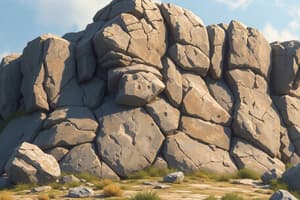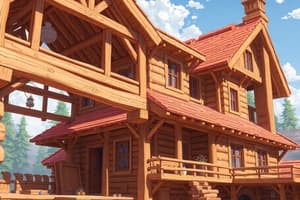Podcast
Questions and Answers
Which building stone is known for its intricate patterns and luminous colors?
Which building stone is known for its intricate patterns and luminous colors?
- Slate
- Sandstone
- Granite
- Marble (correct)
Which building stone is highly responsive to carving and sculpting?
Which building stone is highly responsive to carving and sculpting?
- Granite
- Slate
- Quartzite
- Marble (correct)
Which building stone is often used in large-scale projects like the Washington Monument and the Empire State Building?
Which building stone is often used in large-scale projects like the Washington Monument and the Empire State Building?
- Slate
- Granite (correct)
- Sandstone
- Marble
Which building stone is typically dark in color and popular for roofing due to its durability?
Which building stone is typically dark in color and popular for roofing due to its durability?
Which building stone is formed from the metamorphosis of sandstone and known for its resistance to weathering?
Which building stone is formed from the metamorphosis of sandstone and known for its resistance to weathering?
What is a key characteristic of limestone that makes it a popular choice for construction?
What is a key characteristic of limestone that makes it a popular choice for construction?
Which mineral is a primary component of limestone?
Which mineral is a primary component of limestone?
What makes sandstone resistant to weathering?
What makes sandstone resistant to weathering?
Which iconic structure features the use of sandstone in its construction?
Which iconic structure features the use of sandstone in its construction?
Why is limestone more susceptible to weathering compared to sandstone?
Why is limestone more susceptible to weathering compared to sandstone?
Flashcards are hidden until you start studying
Study Notes
Building Stones: Exploring the Materials that Shape Our Structures
Throughout history, humans have utilized a diverse array of materials to construct our cities, homes, and landmarks. Among these resources, building stones have played a crucial role in shaping our built environment. By delving into the various types of stones employed in construction, we can better understand the foundations and grandeur of our architectural heritage.
Limestone
The most prevalent among building stones, limestone is composed of calcite or dolomite. Its widespread availability and relatively low cost have made it a staple choice for centuries. Limestone has been used in various applications, from monumental structures like the Washington Monument and the Pyramids of Egypt to more modern examples like the Chrysler Building in New York City.
Limestone is relatively soft, making it easy to carve and shape. However, this characteristic also makes it more susceptible to weathering and decay over time.
Sandstone
Sandstone is formed from compressed grains of sand, cemented together by various minerals like silica, iron oxide, or calcite. Because of its composition, sandstone is strong, durable, and resistant to weathering. This material has been used in numerous iconic structures, such as the Colosseum in Rome and the Houses of Parliament in London.
Sandstone's unique properties make it an ideal building stone for arid or semi-arid climates, where it can withstand exposure to precipitation and temperature fluctuations.
Marble
Marble is a metamorphic rock formed from limestone, composed primarily of recrystallized calcite or dolomite. Known for its intricate patterns and luminous colors, marble has been prized for its aesthetic appeal throughout history.
Marble's softness makes it highly responsive to carving and sculpting, as evidenced by masterpieces like Michelangelo's "David" and the Taj Mahal's intricate decorative elements. However, like limestone, marble is susceptible to weathering and erosion.
Granite
Granite is a coarse-grained igneous rock formed from the slow cooling and solidification of molten magma or lava. This hard and durable stone is often used in large-scale projects, such as the Washington Monument and the Empire State Building.
Granite's exceptional strength and resistance to weathering make it an ideal building stone for high-rise structures, bridges, and other large-scale infrastructure projects. Its unique properties also make it resistant to erosion and decay, ensuring its use as a long-lasting building material.
Slate
Slate is a fine-grained metamorphic rock formed from the metamorphosis of clay or mudstone. This stone is typically dark in color, with a smooth, flat surface that has made it a popular choice for roofing.
Slate's durability, low water absorption rate, and resistance to weathering have made it an ideal building material for roofs and walls. Its smooth surface also makes slate an excellent choice for writing slates, signage, and other applications.
Quartzite
Quartzite is a metamorphic rock formed from the metamorphosis of sandstone, composed primarily of silicon dioxide. This hard, durable stone is often used in both architectural and decorative applications, such as the Beinecke Rare Book and Manuscript Library in New Haven and the facade of the John Hancock Building in Boston.
Quartzite's strength and resistance to weathering make it an ideal building material for a wide variety of applications. Its unique properties also make it resistant to erosion and decay, ensuring its use as a long-lasting building material.
In summary, building stones have played a crucial role in shaping our built environment. From limestone to granite, sandstone to quartzite, each material has its unique properties and characteristics, making it suitable for various applications. By understanding the advantages and limitations of these materials, we can better appreciate the structures that have stood the test of time and continue to inspire us today.
Studying That Suits You
Use AI to generate personalized quizzes and flashcards to suit your learning preferences.




